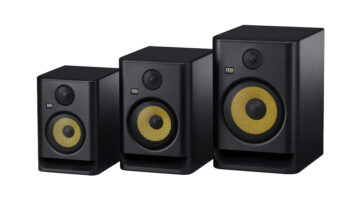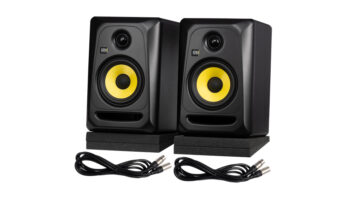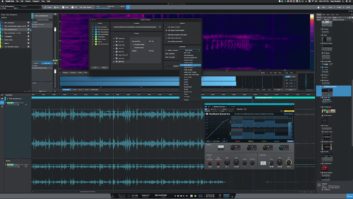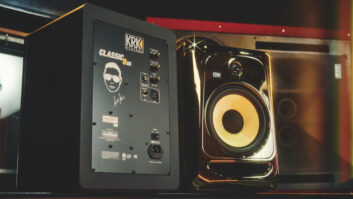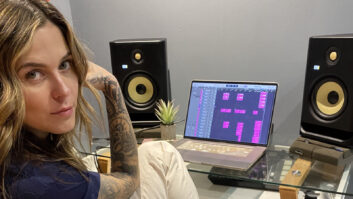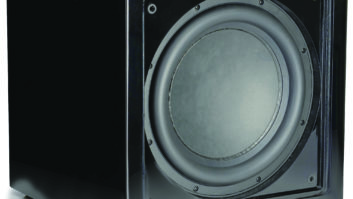
The KRK Rokit Powered Studio Monitors intrigued me because of their incredibly low price. I received the RP-5s, the smallest pair in the line, which sell for $299/pair MSRP, and I liked them immediately. If you’re on a limited budget and need to outfit a stereo or surround listening/editing/mixing station in a small room, then these are the monitors for you.
The Rokit Powered line comprises three models: the RP-5, RP-6 and RP-8. There is also the 150-watt RP-10S RoK bottom powered subwoofer. The numbers 5, 6, 8 and 10 refer to the woofer size in inches, and all models share KRK’s proprietary yellow woofer cone design made of a woven-glass Aramid composite. A single 1-inch neodymium soft-dome tweeter with ferrofluid is used for high frequencies. All models are designed as individual systems with specifically optimized transducers, enclosures and electronics. The models’ tweeter domes are the same proprietary textile material impregnated with a polyester damping material. The voice coil and motor structures differ for each model.
The RP-5 weighs 14 pounds and measures 10⅞×7¼×8⅞ inches. They are made using medium-density fiberboard with rabbet joinery, a central septum and multiple braces. The Rokits have an organic, high-tech feel and are finished in flat black with rounded corners and edges that KRK says reduce edge diffraction and results in better audio imaging. There is a stylish escutcheon plate surrounding the tweeter and woofer and a bass port slot nearly the width of the cabinet at the bottom. This rectangular-shaped port is said to reduce port turbulence as compared to a round one.
The RP-5 frequency response is given as 53 to 20k Hz, ±2 dB. The crossover is at 3 kHz using a custom 24dB/octave crossover filter. The RP-5 uses a 15W amp for the tweeter and a 30W amp for the woofer. Both amp modules are low-noise and distortion DMOS audio amplifier modules made by SGS-Thomson.
PROFESSIONAL REAR PANEL
The rear panel contains all switches, controls and connections, and acts as a heat sink for the built-in amplifiers. There are two level controls: a continuously adjustable input sensitivity knob that goes from -30 dB to +6 dB, and a four-position high-frequency switch with -2, -1, 0 and +1dB positions. For my listening tests, I kept the input set to +6 dB and the high frequency at 0 dB. The rear panel finishes with an on/off switch, a fused 110/220 VAC IEC mains connector and three convenient audio input connectors (XLR and TRS balanced and an RCA unbalanced jack).
PLUG-AND-PLAY MUSIC AT HOME
It’s been great “living” with my pair of Rokits for the past month. I have a small one-man mixing/listening station in one-half of my office. I placed the pair of RP-5s exactly 32 inches apart on either side of my 15-inch flat-panel DAW monitor on small stands — just tall enough to get them at head/ear height. The speakers are shielded.
I liked the monitors’ look: When your head is the third corner of the proverbial near-field monitor equilateral triangle all day and/or night, it helps to have something nice to gaze at.
The RP-5s told me everything good and bad about my recordings and mixes. I was surprised at how well I could hear bass and upper-bass frequencies with only a 5-inch woofer. These monitors are for low to medium volumes and when pushed hard, they tended to scream out with more upper midrange. Panned track positions were easy to hear, and the amplifier electronics were very quiet, so I heard reverb tails all the way down into the DAW’s noise floor. With only 5-inch woofers, you are not going to fill the room with booming subsonics — get a subwoofer for checking that sub octave.
AT THE STUDIO
In a much bigger control room — for a reference point and not as an A/B — I compared the Rokits to a pair of Yamaha NS-10M studio monitors and a pair of Genelec 1031As. The KRKs were smoother and nicer to listen to than the Yamahas — really an “apples to oranges” comparison. The NS-10Ms have a hyped midrange character and the RP-5s easily demonstrated it with a much flatter and smoother overall sound. The KRKs have more and tighter bass than the 6½-inch Yamaha woofer.
The KRKs sounded closer to the Genelecs but smaller in scale. The larger 1051As were more open in the top end and a little brighter. Mixes done with the Genelecs translated well down to the KRKs, with stereo imaging, spectral balance (EQs), reverb levels and dynamics remaining intact. Similarly, mixes made at my office using the KRKs translated equally well on the studio’s Genelecs.
CHECKING OUT
With their small footprint, great low end and low price, the KRK RP-5 Powered Studio Monitors make too much sense not to have. I liked their look and sound, and found them easy to mix music on. I’m sold!
KRK Systems LLC, 805/584-5244, www.krksys.com.
